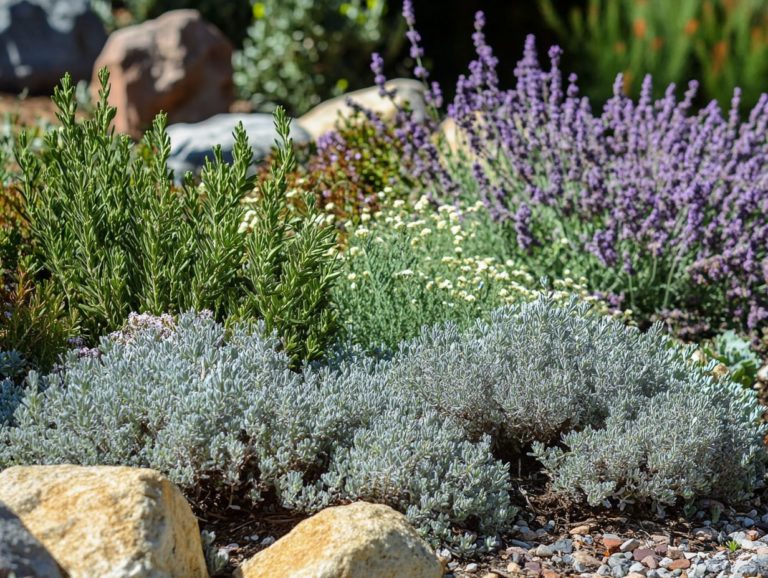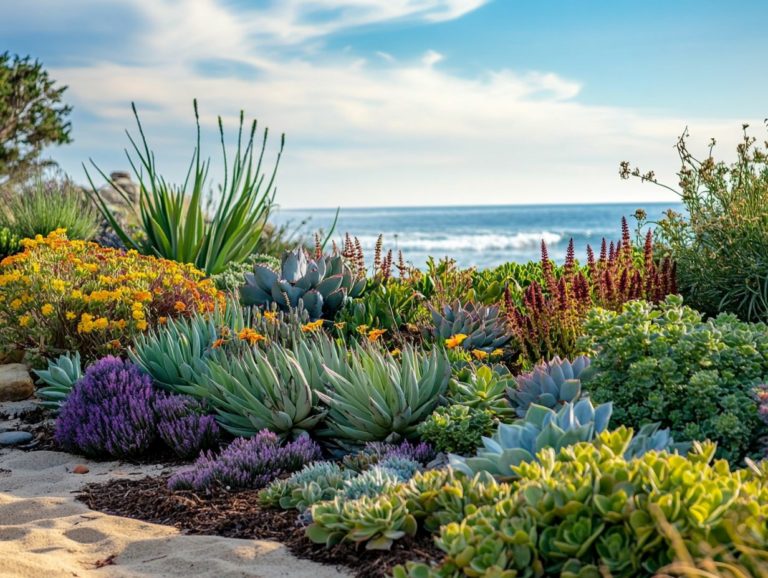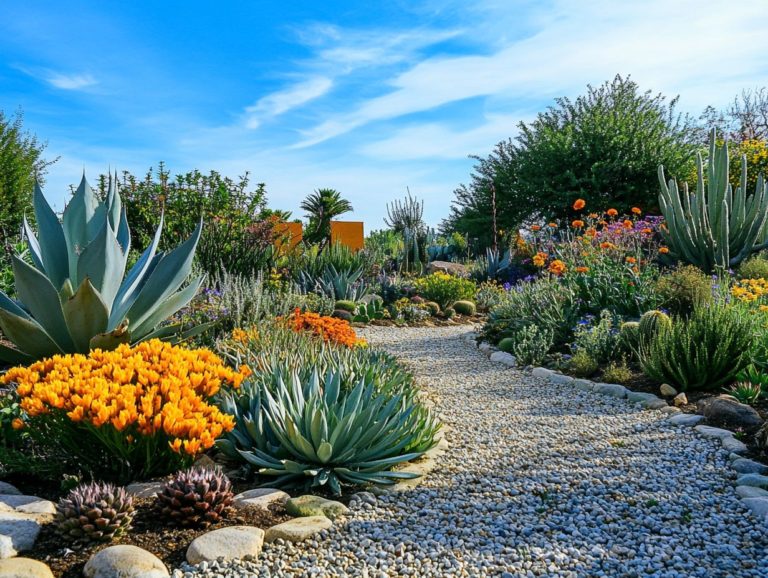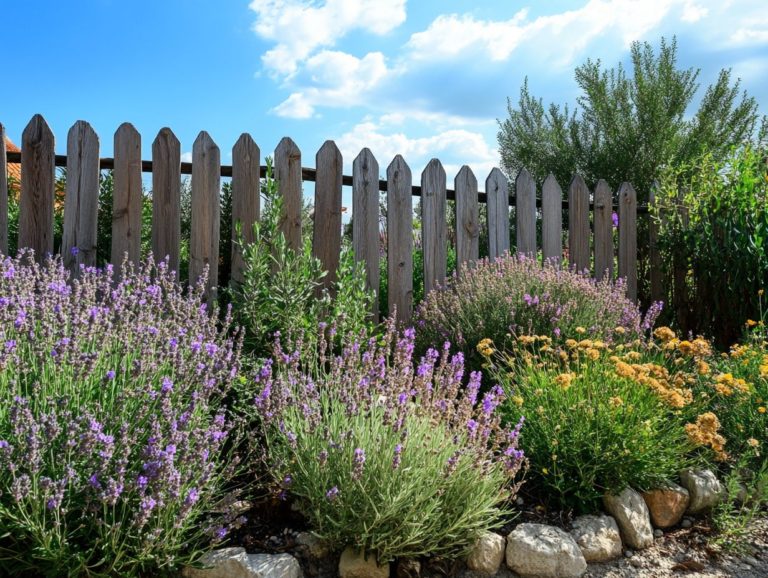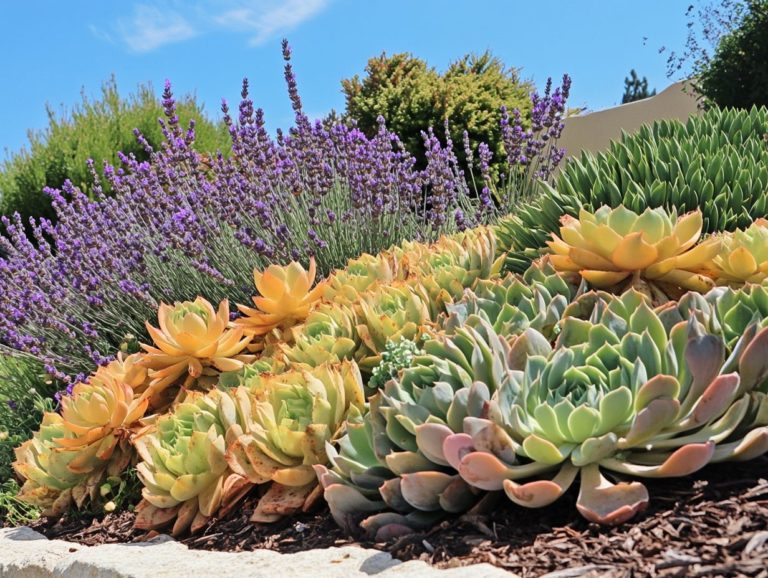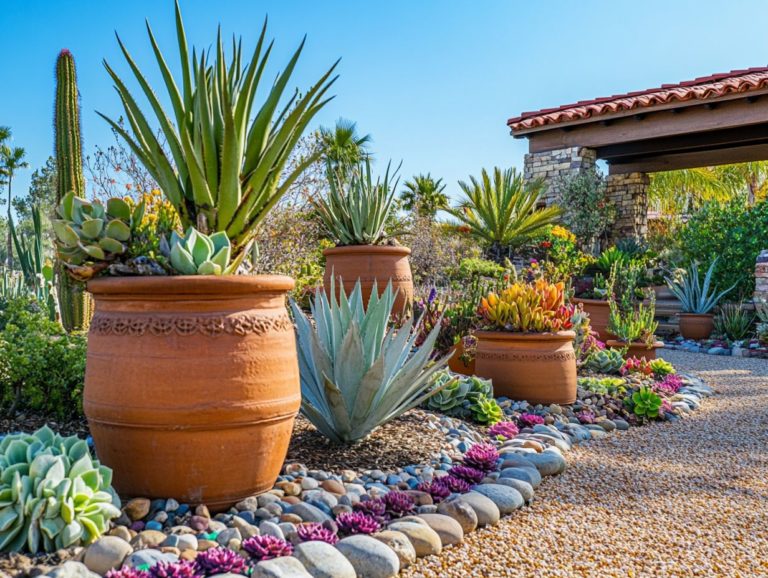10 Drought-Resistant Plants for Arid Gardens
In a time when water conservation is paramount, the thought of cultivating a flourishing garden in dry areas might feel like a challenge, but it s absolutely achievable!
However, with the right plant selection, you have the opportunity to create a stunning oasis that thrives even during dry spells.
This article showcases ten breathtaking drought-resistant plants think succulents, cacti, and lavender that are ideal for any garden.
You’ll also discover essential care tips for these resilient varieties, their numerous benefits, and how to seamlessly integrate them into your landscape design, including insights on soil conditions and the importance of pollinator-friendly plants.
Discover the secrets to crafting a water-efficient garden that not only survives but truly flourishes in the driest of conditions, making it an ecological plant selection for the summer heat and dry weather!
Contents
- Key Takeaways:
- 1. Succulents
- 2. Cacti
- 3. Lavender
- 4. Yucca
- 5. Aloe Vera
- 6. Agave
- 7. Rosemary
- 8. Bougainvillea
- 9. Sage
- 10. Euphorbia
- What Makes These Plants Drought-Resistant?
- Frequently Asked Questions
- What are drought-resistant plants?
- Why are drought-resistant plants suitable for arid gardens?
- What are some examples of drought-resistant plants?
- How do I care for drought-resistant plants?
- Can I use drought-resistant plants in a humid climate?
- Are all drought-resistant plants suitable for arid gardens?
Key Takeaways:
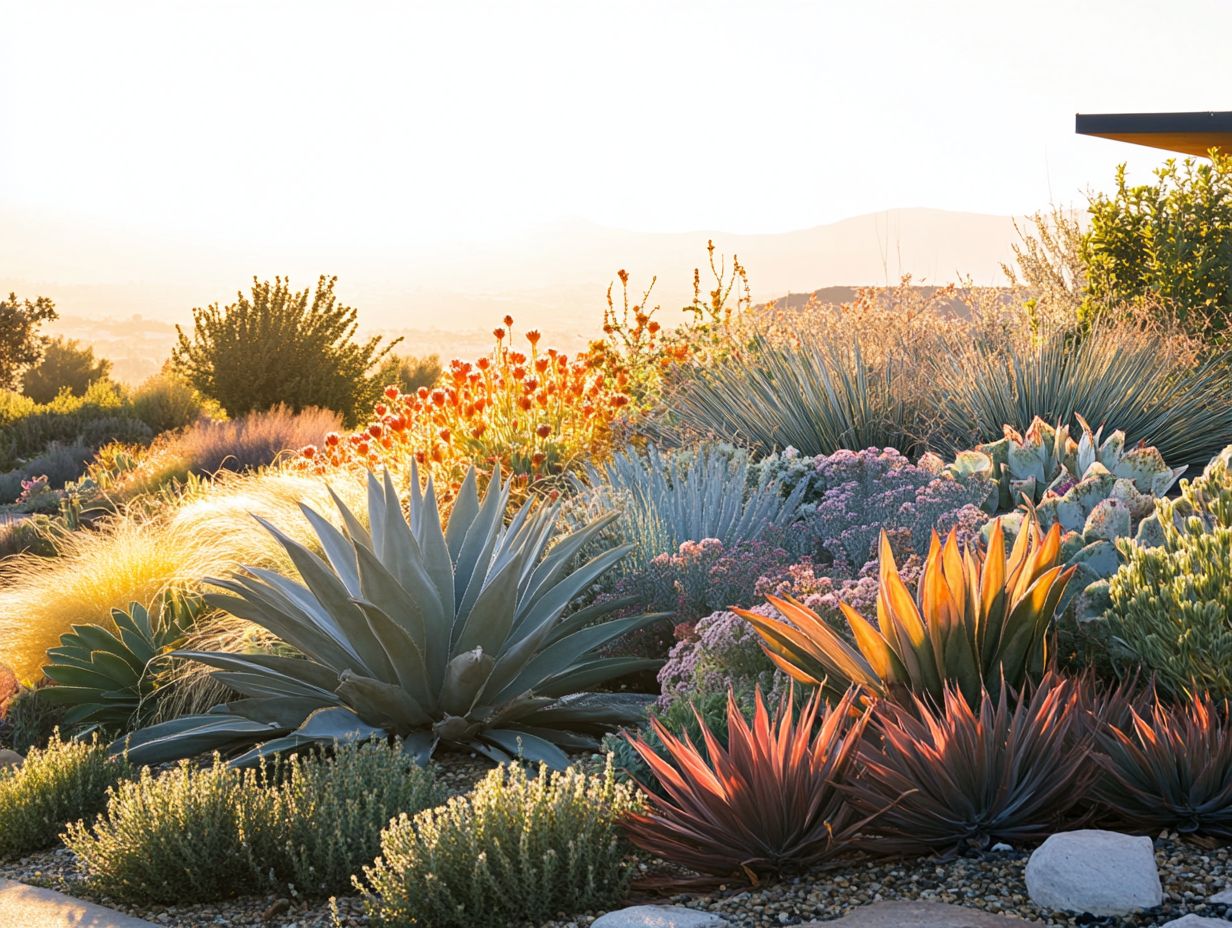
Here are some quick tips to get started on your drought-resistant garden!
- Choose succulents and cacti for low-maintenance, drought-resistant options.
- Incorporate fragrant lavender and rosemary for added beauty and scent in your garden.
- Don t miss out on yucca and agave for their unique structures and ability to thrive in dry areas!
1. Succulents
Succulents, celebrated for their remarkable ability to flourish in dry areas, present an excellent choice if you’re in search of low-maintenance landscaping solutions adorned with vibrant blooms and colors, particularly during the sweltering summer months.
These extraordinary plants come in a wide array of species, each boasting unique textures, shapes, and hues that elevate the visual appeal of your garden.
Some succulents thrive in sandy soils, while others adapt seamlessly to clay, offering versatility for various gardening scenarios.
Beyond their aesthetic charm, many varieties are impressively resilient, requiring minimal watering and care making them ideal for both novice and seasoned gardeners.
Their ability to store water minimizes irrigation needs and enables you to create stunning display arrangements, whether in pots or as part of a more extensive garden design, including container planting options.
This makes succulents a sustainable and attractive choice for diverse outdoor and indoor spaces.
2. Cacti
Cacti stand out as remarkable plants that can survive with little water, expertly crafted to endure dry conditions while offering vibrant blooms that serve as essential habitats for pollinators, reinforcing their role in garden care.
Their unique features, including thick, fleshy stems and a protective waxy coating, enable them to conserve water efficiently, making them a crucial choice for arid landscapes, especially during the summer heat.
Take, for instance, the majestic saguaro or the charming moon cactus these species not only bring visual intrigue to your garden but also support local wildlife.
Their resilience makes them a favored option, requiring minimal maintenance while promoting sustainable landscaping practices.
By incorporating cacti into your garden, you can cultivate a thriving low-water ecosystem that enhances biodiversity and elevates the beauty of your outdoor space, making it a perfect example of ecological plant selection.
3. Lavender
Lavender, a cherished flowering herb, thrives in drought-tolerant conditions, flourishing in the summer heat while showcasing stunning blooms and aromatic foliage.
This resilient plant prefers well-draining soil enriched with organic matter and ideally positioned in full sunlight for at least six hours a day.
These optimal growing conditions not only enhance its vibrant lavender hues and fragrant oils but also attract a delightful array of pollinators, including bees and butterflies, thereby enriching local ecosystems.
Beyond its visual appeal in gardens, lavender serves a crucial role in garden care, providing robust ground cover that helps mitigate erosion.
This versatile herb also enhances various dishes with its unique flavor, while also being celebrated for its soothing medicinal properties, utilized in aromatherapy and herbal remedies that are increasingly sought after.
4. Yucca
Yucca plants are your go-to drought-tolerant perennials that thrive in full sun and well-drained soil. They flaunt striking architectural forms and vibrant flower spikes.
These desert natives come in several species, including Juniperus, each boasting unique features that can elevate your garden s visual interest. For instance, consider the towering, sword-like leaves of Yucca filamentosa or the captivating blooms of Yucca gloriosa. These make perfect focal points in any landscape.
Their hardiness means they can flourish in even the harshest conditions, requiring minimal care once established. Not only do these magnificent plants enhance the aesthetic of your garden, but they also play a functional role in xeriscaping, which is a landscaping method that reduces the need for irrigation by cutting down on water usage and providing shelter for local wildlife. Consider incorporating 5 drought-resistant plants for wildlife gardens to achieve both beauty and sustainability.
When positioned with intention, yuccas can transform your outdoor space into a sustainable and visually stunning environment. Showcase drought-tolerant perennials and enjoy a flourishing landscape.
5. Aloe Vera
Aloe Vera is the quintessential drought-tolerant perennial, celebrated for its low-maintenance appeal and versatility in container planting. It thrives in full sun and is perfect for gardeners at any level.
But it s not just about looks; this remarkable plant offers a host of health benefits too. Think of it as your go-to remedy for soothing skin irritations and burns, providing excellent moisturizing properties.
Aloe thrives in well-draining soil and loves basking in full sun to partial shade. This makes it resilient against neglect, ideal for various indoor and outdoor settings. Its growth habits emphasize minimal watering, promoting sustainable gardening practices that help conserve precious water resources.
By incorporating aloe into your garden, you re not just enhancing the beauty of your space; you re also contributing to a healthier ecosystem. You foster biodiversity and ecological balance, which are essential for any thriving garden.
6. Agave
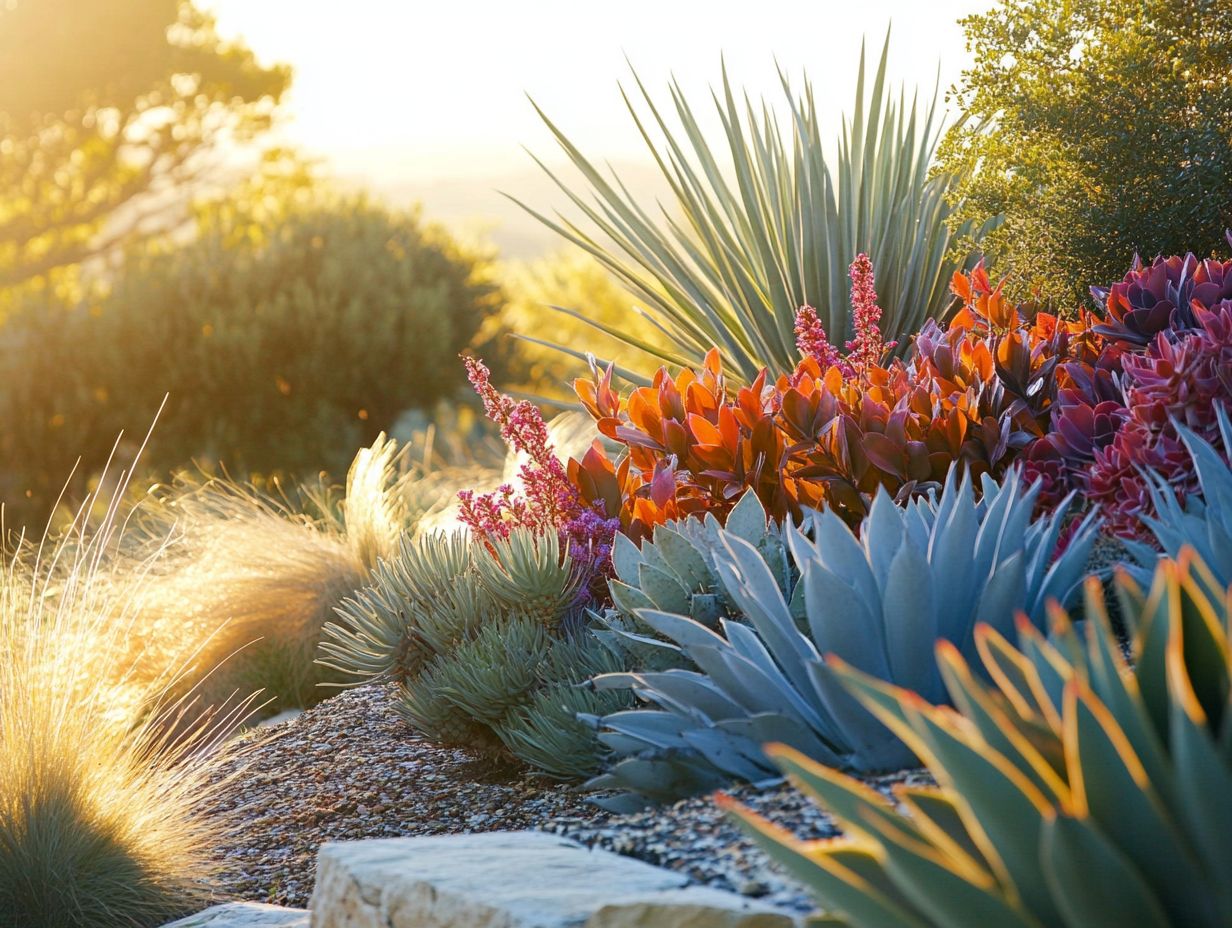
Agave, an exceptional drought-tolerant perennial, is truly a gem in the gardening world. It is celebrated for its vibrant hues and unique shapes, quickly becoming a favorite among landscape consultants.
With over 200 species available, this adaptable plant not only thrives in low-water conditions but also introduces stunning texture and visual intrigue to your garden. Varieties like Agave americana and Agave tequilana stand out with their dramatic rosettes and striking blue-green foliage, enhancing both modern and traditional aesthetics.
By incorporating agave into your landscape design, you can create eye-catching focal points or elegant borders. This elevates overall beauty while championing sustainability with their minimal irrigation needs. Perfect for xeriscaping projects, their resilience and captivating look empower you to craft landscapes that are not just visually appealing but practical as well.
7. Rosemary
Rosemary, the fragrant flowering herb, is a true gem in your garden. It thrives as a drought-tolerant perennial, delighting your palate with culinary uses and dazzling with beautiful blooms, resilient even under the sweltering summer sun.
You ll find rosemary enhancing a medley of dishes, elevating the flavors of meats, vegetables, and breads. To grow this aromatic herb successfully, ensure you have well-draining soil, ideally with a pH of 6.0 to 7.0, and a sunny spot that basks in six to eight hours of direct sunlight daily, which is essential for flowering herbs.
Its fragrant flowers attract bees and other beneficial pollinators, making rosemary an excellent choice for gardeners keen on fostering biodiversity. With its remarkable ability to thrive in various environments, rosemary stands out as both a culinary treasure and an ecological ally.
Transform your garden today by incorporating these incredible drought-tolerant plants!
8. Bougainvillea
Bougainvillea truly shines as a vibrant, drought-tolerant perennial, celebrated for its stunning colors and remarkable ability to flourish in challenging landscape conditions.
With various species, from the classic Bougainvillea glabra to more resilient hybrids, you have an array of options to explore within your garden designs. These showcase both flowering plants and native plants. Landscapers adore these hardy plants not just for their visual appeal but also for their low water requirements. This makes them perfect for sustainable gardening practices.
By incorporating different varieties, you can craft a breathtaking palette of colors that evolves with the seasons. This adds layers of visual interest to your space. Thoughtful placement around pathways, trellises, or as ground cover can maximize their impact while conserving resources. This demonstrates that beauty and eco-friendliness can indeed coexist harmoniously in your outdoor oasis.
9. Sage
Sage, a versatile flowering herb, stands out as a remarkable drought-tolerant perennial that beckons pollinators and enriches your garden with its distinctive aroma and stunning blooms.
This herb doesn t just elevate your culinary creations with its bold flavor profiles; it also boasts an array of medicinal properties, making it a valuable asset in your herbal repertoire. You can infuse its leaves in teas or utilize them in natural remedies to support digestion and enhance your overall well-being, showcasing sage’s numerous health benefits.
Beyond its practical uses, sage truly excels in ornamental gardens. It presents a delightful mix of textures and colors that can beautifully complement both contemporary and traditional designs. With minimal maintenance required, it thrives effortlessly across a variety of climates, offering you a splendidly resilient choice for elevating your outdoor spaces.
10. Euphorbia
Euphorbia is a remarkable group of drought-tolerant perennials that flourishes in well-drained soil. This presents you with innovative options for crafting sustainable gardens.
Among the many species, you ll discover everything from the striking Euphorbia milii, known as the crown of thorns, to the intriguing Euphorbia ingens, also called the African milk barrel. Each variety boasts distinct features, showcasing fascinating foliage and vibrant flowers that add a burst of color, even in arid conditions.
Their hardiness makes these plants perfect for various climates, requiring minimal care once they’re established.
The ecological benefits they offer are substantial. They attract pollinators and act as natural pest deterrents, enhancing the biodiversity in your garden space. Why not incorporate these resilient plants? You can create a visually captivating and low-maintenance landscape that thrives with minimal water.
What Makes These Plants Drought-Resistant?
The drought-resistant qualities of these plants stem from a remarkable blend of adaptations. Their ability to flourish in poor soil conditions and endure intense summer heat makes them perfect for water-saving gardens and sustainable gardening.
These adaptations often include specialized root systems designed to efficiently absorb moisture from deep underground. They also have waxy surfaces that minimize water loss. Many of these resilient species feature altered leaf structures that reduce transpiration, which is the process plants use to release water into the air. This allows them to conserve water while still photosynthesizing effectively.
By grasping these biological traits, you not only gain insight into the advantages of incorporating these plants into your landscape but also enhance your ecological plant selection strategies. This fosters a diverse garden ecosystem. This approach enables you to significantly reduce water usage while crafting a visually stunning environment that thrives even in the harshest conditions.
Start your sustainable garden today!
How to Care for Drought-Resistant Plants
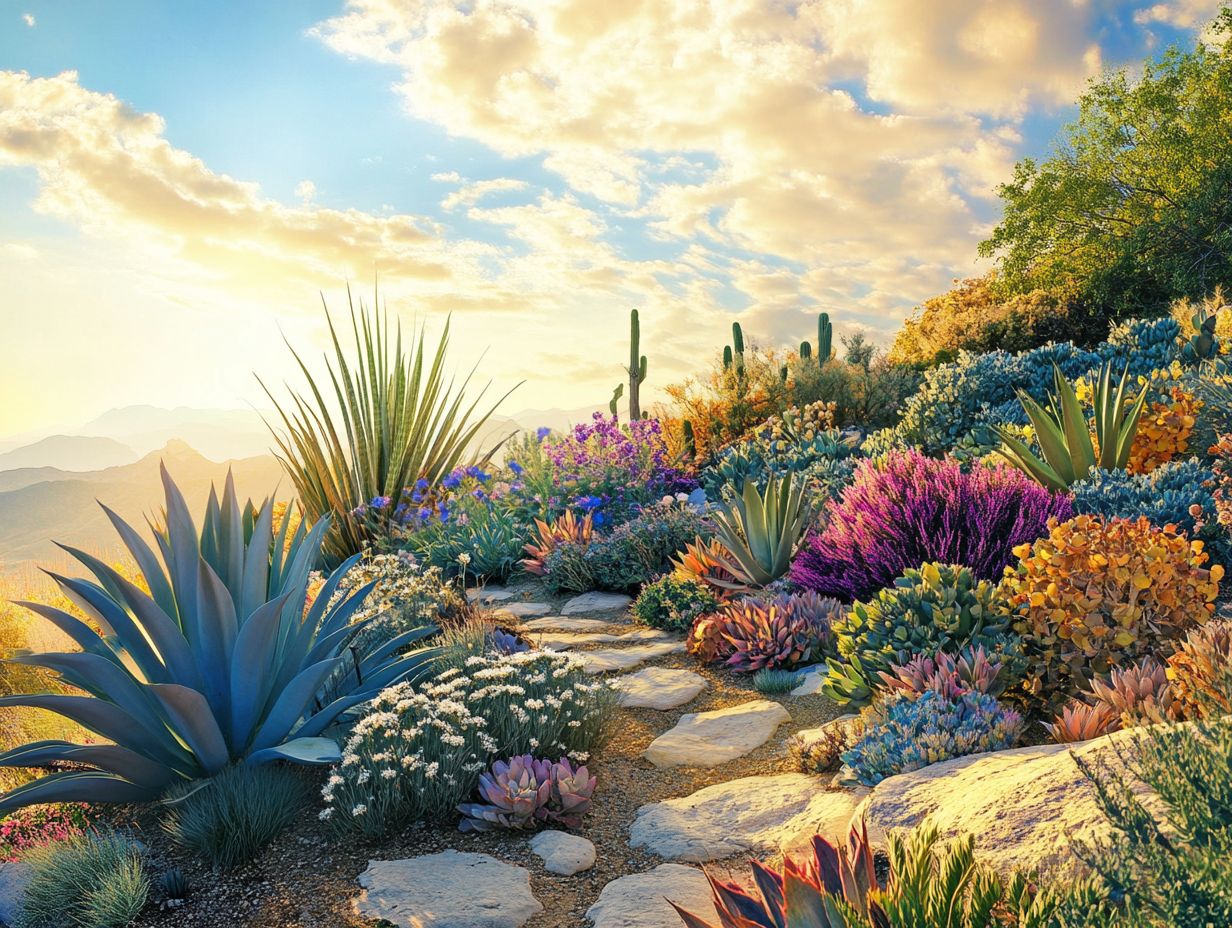
Caring for drought-resistant plants requires a refined touch where your gardening expertise shines. To enhance your garden, consider incorporating the top 10 drought-resistant ground covers for gardens. Focus on well-drained soil, precise watering techniques, and understand each species’ unique needs.
To help these hardy plants thrive in dry conditions, a customized watering schedule is essential, aligning with their growth stages and local climate. Watering deeply but infrequently encourages roots to delve into the soil for moisture, fostering strong development.
Enhancing your soil with organic compost improves its structure and moisture retention, promoting better root growth and nutrient absorption. Applying mulch during warmer months maintains consistent soil temperature and moisture levels.
This nurturing approach creates a healthier environment for resilient species, allowing them to flourish under your care.
What Are the Benefits of Having Drought-Resistant Plants in Your Garden?
Adding drought-resistant plants to your garden offers many benefits, including a low-maintenance landscape and reduced water usage.
These resilient perennials enhance soil health; their strong root systems help prevent erosion and facilitate nutrient cycling. By enriching the soil, they create a thriving habitat for beneficial microbes and insects.
From an economic perspective, these plants require less irrigation, leading to lower utility bills and gardening costs over time. Aesthetically, the diverse textures and colors of drought-tolerant species provide year-round visual interest, transforming your landscape into a vibrant oasis.
Not only do you conserve water, but you also positively contribute to the ecosystem.
How Can You Incorporate These Plants into Your Garden Design?
Incorporating low-water plants for sustainable landscapes can transform your outdoor space into a visually stunning landscape while embracing sustainable gardening practices.
These remarkable plants not only conserve water but also thrive in various settings, making them ideal for borders, rock gardens, and water-efficient gardens. By thoughtfully selecting complementary species, like pairing the soft, silvery foliage of lavender with the bold blooms of coreopsis, you can create a harmonious blend of textures and colors.
Mixing succulents with ornamental grasses introduces depth to your landscape. This not only elevates the aesthetic but also creates habitats that support local wildlife, fostering a balanced ecosystem in your backyard.
What Are Some Other Drought-Resistant Plants to Consider?
Exploring drought-resistant plants opens a world of gardening possibilities, including native varieties and diverse flowering plants that enhance both beauty and resilience.
Consider the purple coneflower; it s not just a feast for the eyes but also attracts pollinators, adding life to your garden. Another great option is sedum, with its fleshy leaves and star-shaped flowers, providing texture and visual intrigue.
Don t overlook yarrows they thrive in low-water conditions and offer a natural aesthetic with their delicate foliage and flat-topped flower clusters. By incorporating these plants, you create a stunning tapestry of colors and forms while ensuring your garden remains low-maintenance, even during dry spells.
Get ready to transform your garden! Start today and watch your garden thrive!
How Can You Create a Water-Efficient Garden?
Creating a water-efficient garden requires careful planning. Select drought-tolerant plants and understand your soil conditions to help retain moisture.
Using mulch significantly reduces water evaporation. This helps your plants thrive even during dry spells.
For irrigation, consider drip systems. They deliver water through small tubes that aim directly at the roots, allowing for efficient watering and minimizing waste.
Choose native species for your garden. These plants are well-suited to your local climate and reduce the need for extra watering.
By combining these strategies, you can conserve water while cultivating a vibrant and sustainable garden.
Frequently Asked Questions
What are drought-resistant plants?
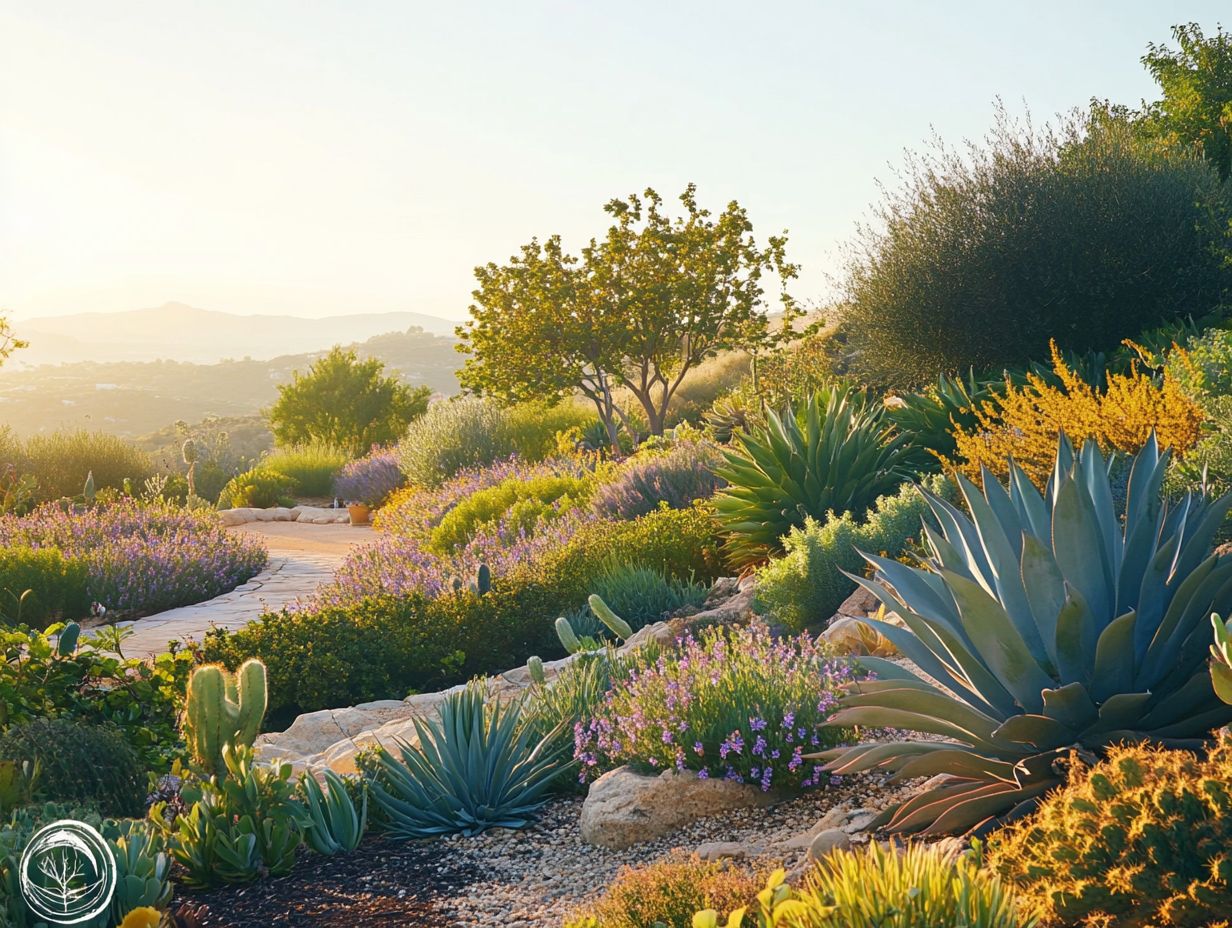
Drought-resistant plants can survive in dry conditions with minimal water. They store water and endure long periods of drought.
Why are drought-resistant plants suitable for arid gardens?
These plants thrive in hot, dry climates and need little watering. Their low maintenance makes them perfect for areas with limited water, making them ideal choices like the 7 drought-resistant plants for low maintenance.
What are some examples of drought-resistant plants?
Common examples include succulents, cacti, lavender, yucca, agave, and rosemary. For those looking to enhance their gardens, consider the 10 drought-resistant plants for coastal areas, as these plants have adapted to survive in dry conditions.
How do I care for drought-resistant plants?
Plant them in well-drained soil and provide occasional deep watering. Avoid overwatering and use mulch to retain moisture.
Can I use drought-resistant plants in a humid climate?
Yes! They can thrive in humid conditions if planted in well-drained soil and not overwatered.
Are all drought-resistant plants suitable for arid gardens?
No. Some prefer moister environments or may not tolerate extreme heat. Research plants that suit your region’s arid conditions.

